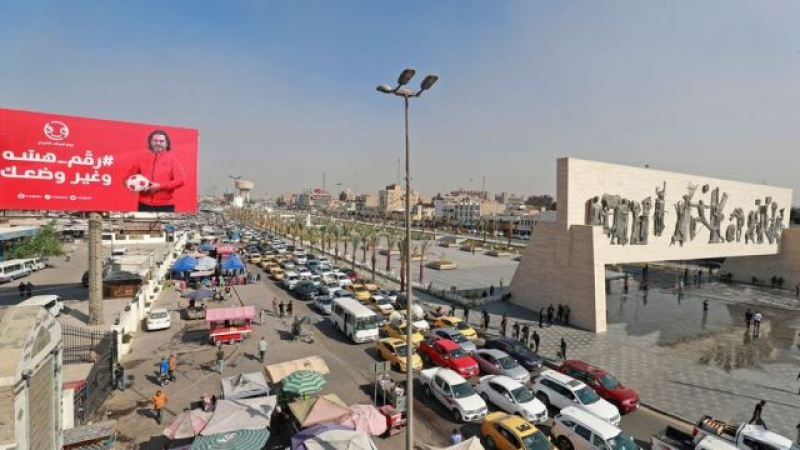- UN Chief Calls for Urgent Climate, AI and Global Reform |
- Consensus not to use emergency for political ends: Ali Riaz |
- Sunamganj’s age-old boat market dull as normal floods rare |
- Italian PM Giorgia Meloni to Visit Bangladesh on Aug 30-31 |
- BNP to Get 38.76% Votes, Jamaat 21.45%, NCP 15.84% |
2 decades after Iraq war: what about promise of girl education?

Traffic in Baghdad Tahrir Square
Jehangir Hussain
Twenty years ago Iraqi women and girls were promised a new future of liberation and education by former US president Bush. The reality is different, writes Balsam Mustafa in the Guardian.
Coming home late in the evening as a young girl in the southern Iraqi city of Basra, Zainab, then 15, feared each day could be the last time she could go to school. Living in a conservative district in Basra province, where females out alone in the evening are frowned upon, Zainab’s family were not happy about it. They were also concerned about her safety.
Her school, like many in Iraq, had been forced to divide and rotate pupils into morning, afternoon and evening shifts as there were not enough buildings available to accommodate all the students at once.
The late evenings led to arguments with her family, but her parents’ faith in education, despite their illiteracy, meant Zainab was able to complete her education – though not in Iraq, as her family later left for Jordan, escaping conflict and instability.
“I was a smart and hard-working student. But in both Iraq and Jordan, I was always fearful I would have to drop out,” says Zainab.
Other girls have not been so fortunate. Unicef estimates that about 3.2 million school-age Iraqi children are out of school.
It’s a far cry from the vision outlined by President George W Bush in March 2004, a year after the US-led invasion of Iraq. At the time, a new future of liberation and education for women and girls had been part of the moral justification for the invasion.
“For women and girls, liberation has a special significance. Some of these girls are attending school for the first time. It’s hard for people in America to imagine. A lot of young girls now get to go to school,” Bush had said in 2004, with reference to Afghanistan and Iraq.
The education system had already been affected by a decade of sanctions and the three wars waged during the Ba’athist era. In 2004, a study published by the Iraqi education ministry and Unicef found the education system lacked the basics necessary to provide children with adequate education, especially girls, whose enrolment was lower than boys across all grades.
It has not improved over the past two decades. Only 6% of the state budget has been allocated to education despite its importance for economic growth. For girls, education opens up new possibilities through career development or entrepreneurship, as well as the potential for them to create more economic opportunities for others.
Girls are also at an increased risk of dropping out as they progress through education, with one in 14 girls in Iraq aged between 15 and 19 giving birth, according to estimates by the charity Save the Children.
As of 2017, Iraq had the lowest female literacy rate (79.9 per cent ) in the region, below the global average of 83.3 per cent . This is despite article 34 of the Iraqi constitution, which stipulates that primary education should be free and obligatory for all children.
However, international aid and investment is not the only issue, according to former students from before and after the invasion who spoke to the Guardian and Hummar, an independent Iraqi media platform.
The fall of Saddam Hussein in 2003 didn’t mean that existing laws changed overnight. This includes a penal code from 1969 that enables parents and teachers to “discipline children”.
The education ministry has stipulated that the veil should not be compulsory in schools. However, the 2005 Iraqi constitution states that Islam is the official state religion and should be the “foundation source” of legislation.
Occasionally, female students and some teachers share their experiences online using hashtags that highlight their oppression, such as “#educationalterrorism” and “#notothecompulsoryveil”.
Get a different world view with a roundup of the best news, features and pictures, curated by our global development team
Former students have also talked about the role of the “communicators of the message” – females affiliated to political parties or religious institutions who spread Islamic notions and urge younger students to wear the hijab.
Hadil, a teacher in one of Baghdad’s elementary schools, has been blocked from using modern teaching methods in class, such as playing music and songs and was even assaulted and blackmailed by a student’s family because she reminded a child to wear a coat in winter.
“I was in big trouble and the teacher protection laws didn’t protect me. It is mere ink on paper,” says Hadil. “Teachers may also be pressured to make some students pass, which affects the already deteriorated quality of education.” The post-2003 culture of corruption and nepotism enabled by the political class has encouraged these practices to spread across all institutions, she says, including schools.
“Educational institutions are connected to and steered by religious institutions. That’s why, in the elementary school where I work, I ask children to say ‘long live Iraq’ when I enter class, rather than ‘long live Islam’, which is what they normally have to say,” says Hadil.
“I still try to make a difference. It’s a small attempt in the face of an entire system of outdated laws and customs, as worn-out institutions destroy us all – students and teachers,” she says.
jehangirh01@gmail.com

